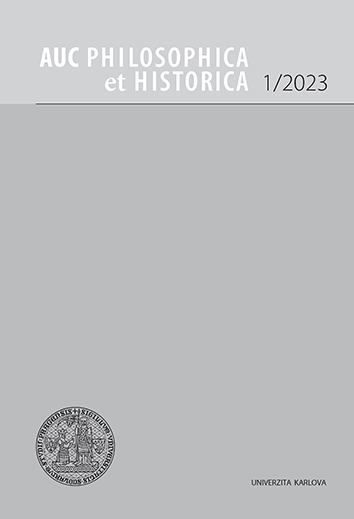AUC Philosophica et Historica je víceoborový akademický časopis zaměřený na humanitní a společenskovědné obory (filozofie, psychologie, pedagogika, sociologie, obecné, české a hospodářské dějiny, pomocné vědy historické a archivnictví, etnologie).
Časopis je indexován v databázích CEEOL, DOAJ a EBSCO.
AUC PHILOSOPHICA ET HISTORICA, Vol 2019 No 2 (2019), 219–227
Konceptuální přístup v tématu zobrazování křížové cesty
[Display of the Stations of the Cross and the conceptual approach]
Hana Lamatová
DOI: https://doi.org/10.14712/24647055.2020.15
zveřejněno: 14. 09. 2020
Abstract
The perception of the Stations of the Cross is constantly oscillating between visual perception and the acceptance of a verbal description. In the beginning, people taking part in historical events (Jesus Christ went to the execution with the cross in the streets of Jerusalem) perceived and experienced what others later tied to words. (Leaving aside the oral history, the first biblical text appeared in the 1st century, and the text tradition of records of the Stations of the Cross’s piety dates back to 1471.) An effort to convey the described historical event through the senses meant adding an image to the text (for the first time in 1423 or 1425). The long period of coexistence of the verbal description and the corresponding visual concepts was gradually disrupted by artists during the 20th century until its last decades in which the artists almost achieved independence of an image from the traditional theme. They did it through an emphasis on expressing inner reality and overcoming the subject reality. They created a new system of symbols suppressing the traditional Stations of the Cross’s image. This artistic concept sees a creative role in the hands of the subject, both the author of the work and his observer. As an accompaniment to this new image, another verbal description appears interpreting blank spaces between the work and the recipient. This transformation will be interpreted on the several artworks.
klíčová slova: Czech art of the 21th century; Display of the Stations of the Cross; Conceptualization of a traditional motif; Transformation of a perception the sacral art pieces
reference (16)
1. Christiaan van Adrichem, Iervsalem, sicvt Christi tempore florvit, et suburbanorum, insigniorumq[ue] historiarum eius breuis descriptio: simvlet locorvm, qvae Iesu Christi et sanctorum passione gestisq[ue] decorata sunt, succinctus commentarius, Köln am Rhein 1584.
2. Renata Bartoňová - Josef Veselý, Křížová cesta pro tebe i pro mne, Petrov u Strážnice 2001. Martha Bayless (ed.), Collectanea pseudo-Bedae, Dublin 1998.Iohannes de Caulibus, Meditationes uitae Christi, Augsburg 1468.
3. James D. Douglas (ed.), Nový biblický slovník, Praha 2009.
4. Vratislav Effenberger - Anna Fárová et al., Mikuláš Medek (kat. výst.), Galerie Rudolfinum Praha 2002.Zdeňka Jančíková, Kostel sv. Václava Sazovice, Sazovice 2017.
5. Ludmila Jandová - Josef Suchý, Křížová cesta, Březnice 2004.
6. Lubomír Jarcovják, Bukovany Křížová cesta, [Bukovany] 2010.
7. Engelbert Kirschbaum (ed.), Lexikon der christlichen Ikonographie: allgemeine Ikonographie. Bd. 2, Fabelwesen-Kynokephalen, Rom 1990.
8. Josef Kouřil - Lubomír Jarcovják (edd.), Bukovany. Kaple sv. Jana Pavla II, Zlín 2014.
9. Ernst Kramer, Kreuzweg und Kalvarienberg. Historische und baugeschichtliche Untersuchung, (Studien zur deutschen Kunstgeschichte, Band 313), Kehl - Strassburg 1957.
10. Gerhard Kroll, Po stopách Ježíšových, Kostelní Vydří 2002.
11. Pavel Lazárek - Zdeněk Peša, Křížová cesta bolestí regionu Olešnicka, Olešnice 2016.
12. Gerhard Müller et al., Theologische Realenzyklopädie, Band XXVII, Politik/Politologie - Publicistik/Presse, Berlin 1997.
13. Jan Pascha, Pelgrimsreis naar het heilige land (Peregrinatio spiritualis), Brussel 1593 [?].Jan Royt, Slovník biblické ikonografie, Praha 2006.
14. Kurt Schubert, Bible a dějiny, Svitavy 2000.František Tomášek - Jan Lebeda, Velikonoční cesta, Praha 1982.
15. Wilhelm Ziehr, Kříž: Symbol: Zobrazování: Význam, Kostelní Vydří 1997.
16. Josef Zvěřina, Dílo jako znak, Praha 1971.

Konceptuální přístup v tématu zobrazování křížové cesty is licensed under a Creative Commons Attribution 4.0 International License.
